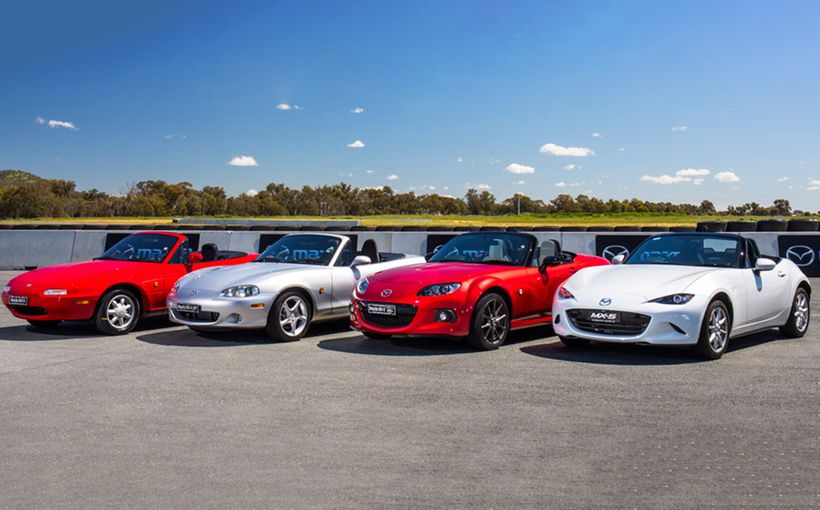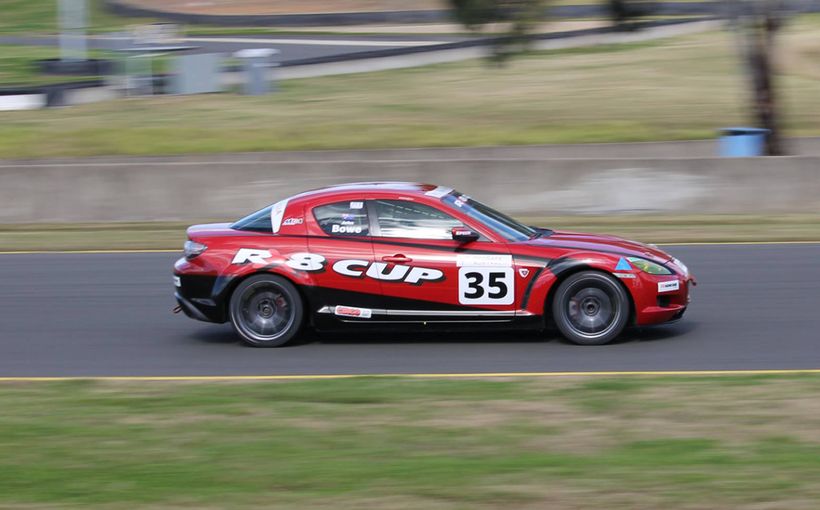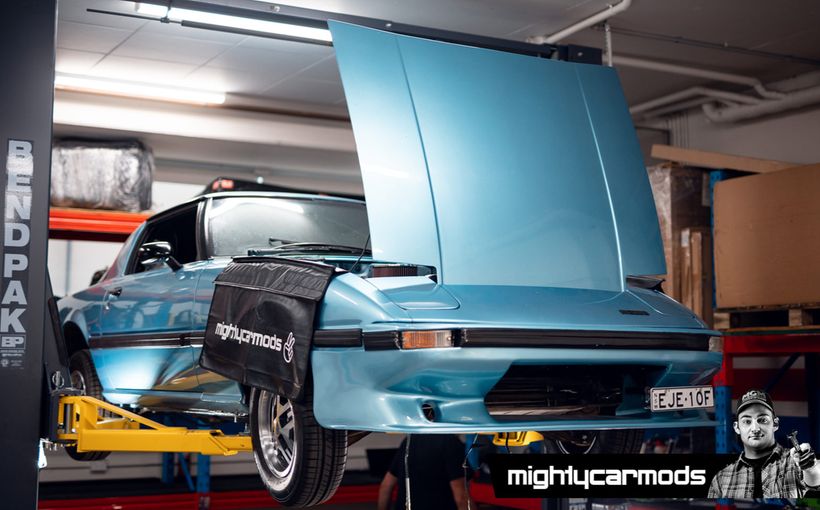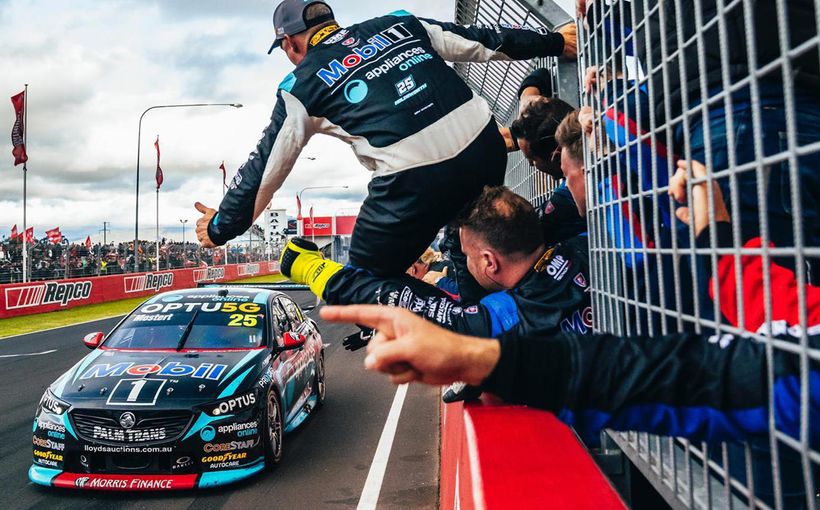Mazda RX-2: Bathurst’s First Rotary Winner

Mazda’s R100 was the first rotary-powered sedan to compete in the annual 500-mile (800km) endurance race for production cars at Bathurst in 1969, but the Japanese manufacturer had to wait another two years for its historic first class win with the RX-2 in 1971.
Launched in 1970, the RX-2 (aka Capella RE) like the R100 shared engine bays with one of Mazda’s conventional piston-engined models - in this case the stylish new Capella 1600. Available in a choice of four-door sedan or coupe body styles, the RX-2 was larger than the R100 in all key dimensions including wheelbase (2468mm), width (1371mm) and length (4150mm) with a 960kg kerb weight that was about 100kg heavier.
Despite these size and weight increases, the RX-2 with its MacPherson strut front suspension featured a multi-link coil-sprung live rear axle which was more sophisticated and better behaved than the R100’s wayward leaf-spring design. The Capella’s larger and more refined chassis provided a superior foundation for Mazda’s second attempt at a mass-produced rotary-powered sedan, with greatly improved handling that delivered on the race track.
The RX-2 was also more powerful than the R100, with the larger twin-rotor 12A engine in place of its predecessor’s 10A unit. The 12A’s pair of 573cc rotors had a combined cubic capacity of 1146cc. However, because motor sport’s world governing body the FIA was so impressed with the efficiency of the rotary design, it was considered to be the equal of a conventional reciprocating engine of twice its capacity. Hence the 12A’s 1146cc rating was doubled to a notional capacity of 2292cc.
With 120bhp at 6500rpm and a safe redline of 7000rpm, the four-speed RX-2 loved to rev and had power to burn, with high 16-second standing quarters and a scintillating top speed of almost 120mph (190km/h). It was those performance attributes which made the RX-2 a genuine Bathurst class contender and bring Mazda its first rotary-powered success at Mount Panorama.

1971 Hardie-Ferodo 500
The RX-2 made its Bathurst debut in the 1971 Hardie-Ferodo 500 when the entry list was divided into classes based on retail prices rather than engine capacities. The new Mazda was therefore in Class C for cars costing between $2501-$3150, where it would face two formidable opponents in Holden’s LC Torana GTR and Ford’s Escort Twin Cam.
The Torana GTR proved how effective an engine from a large family sedan shoehorned into a much smaller car could be. With a compact 2540 mm wheelbase and athletic 1018 kg kerb weight, it was powered by a higher performance two-barrel version of the Kingswood’s 161 cid (2.6 litre) in-line six. In this hotter 2600S form, GM-H claimed 125 bhp (93 kW) which blessed the four-speed manual GTR with spirited standing 400-metre times of just over 17 seconds and top speeds exceeding 105 mph (170 km/h).
Ford’s Escort Twin Cam (aka GT1600) was an equally tough class rival with a shorter 2400mm wheelbase and very light 830kg kerb weight. Its potent Lotus-designed 1.6 litre DOHC four cylinder engine with 115bhp (86kW) produced similar 400-metre times and top speeds to the GTR, presenting the new RX-2 with some serious competition.

Two dealer-entered Mazdas were entered for the 1971 clash crewed by Wayne Rogerson/Allan Mayne and Gary Cooke/Gary Holmes, with Cooke electing to drive the full 500-mile distance solo. Class C attracted a healthy list of rivals including two LC Torana GTRs, three Escort Twin Cams, two S-type Mini Coopers, a Honda 1300S coupe and a lone Ford Cortina 2000 L.
During practice the new more powerful Mazdas proved to be very fast in a straight line, just like their R100 predecessors, with the high-revving 12A rotary engines producing unmatched top speeds on Conrod Straight exceeding 120mph (190km/h).
And with their superior handling, the RX-2s set the pace in qualifying too with Rogerson/Mayne on pole position ahead of the Ross Hewison/Brian Hones Escort Twin Cam, Gary Cooke’s RX-2 sedan and the Geoff Wade/Geoff Perry Torana GTR.
As the starting grid suggested, the Class C battle in 1971 proved to be a close and tough encounter between the Mazdas and their Ford and Holden foes, as described by Bill Tuckey in Chevron Publishing’s seminal Australia’s Greatest Motor Race:

“On the first lap Hewison’s Escort led Cooke, Rogerson, Wade, Brewster and Cant, but Cooke took over on lap two as on lap four Moffat (Falcon GT-HO) began lapping this class in his blasting progress towards a devastating win. Rogerson put his Capella (RX-2) into the lead not long afterwards ahead of Cooke (RX-2) and Brewster’s bronze GTR Torana, but Brewster, sick with stomach troubles, rushed in to hand over to co-driver Ray Strong.
“The Bill Stanley Mini picked up some of the fencing wire (dragged onto the circuit in an earlier incident), hit a Falcon when the wire cut a brake line and then bounced off the fence. By the time everything settled down Cooke was again back in the lead and the stayed there for probably two hours, with fencing wire still emerging in the braking department of some of the other cars.
“Rogerson started chasing him in the Capella (RX-2) but bounced off the fence late in the race. Cooke was much faster than his listed co-driver (and owner of the car) Gary Holmes. Cooke’s eventual winning margin of just 20 seconds over Wade/Perry (Torana GTR) amply vindicated his decision not to give Holmes a drive in the race.”
Gary Cooke’s victory was well deserved, as he had wrestled the recalcitrant R100 to its highest placing on debut two years before. The RX-2 also proved that Mazda’s bold decision to back Dr Felix Wankel’s radical engine design was the right one. It not only beat the best piston-engined pocket rockets from Ford and Holden fair and square but in claiming 26th place outright also finished ahead of numerous Falcon GT-HOs, R/T Chargers and Torana XU-1s.

1972 Hardie-Ferodo 500
The annual Bathurst 500 had, since its inception in 1963, adhered to a multiple class structure based on showroom prices. However, in 1972 Australian motor sport's governing body CAMS and race organisers finally acknowledged the importance of grouping cars based not only on price but also engine capacities to ensure close competition.
In 1972 a new class system for the five-round Manufacturer's Championship (including Bathurst) was based on a formula which multiplied a car’s retail price in Sydney with its engine capacity measured in litres. This resulted in a number of capacity/price units or CPUs. Although widely misunderstood and only used once, the CPU system did result in a four-class structure with cars that were closer in outright performance terms than some of the grossly unfair contests of previous years when showroom price was the sole determining factor.
As a result, the RX-2 was in Class B (3001 to 9000 CPUs) which attracted three entries driven solo by Wayne Rogerson, Bernie Haehnle and George Garth. The trio of Mazdas was seriously outnumbered by Ford’s very quick Escort Twin Cam, with a total of 10 entries and some quality driving talent including Barry Seton, Bob Holden and Digby Cooke. The remainder of a bumper 19-car Class B was made up of Torana GTRs, Datsun 1600s, a Fiat 124 coupe and an LJ Torana 2850S for the all-girl crew of Christine Cole/Jan Holland.

Although rain was forecast for Sunday morning, Saturday’s practice sessions were held on a dry track and again the flying Wayne Rogerson in his RX-2 ripped around the Mountain to secure his second class pole position in two years. Two Escorts and the remaining RX-2s rounded out the top five grid slots, setting the stage for another great Mazda v Ford battle as a huge crowd crammed onto Mount Panorama for the first wet start to the ‘500’.
“In Class B Rogerson’s Capella led four Twin Cam Escorts away from the start,” Tuckey recalled after competitors had been in a muddle trying to figure out the best tyre choice for the tricky wet conditions which were forecast to dry out.
“There were cars on dry tyres and intermediates, Bridgestones, Dunlops and Goodyears. Jim Murcott’s Escort Twin Cam led for three laps until he came in for a tyre change, leaving the Geoff Leeds Escort and the George Garth Capella (RX-2) out in front of Rogerson (RX-2) and Seton (Escort) – who was soon to have ignition problems which cost him half a lap.

“By lap 27, as the track dried, Leeds (Escort) and Garth (RX-2) were almost a lap clear of the others. Murcott (Escort) had given up on lap 23, violently sick from exhaust fumes leaking into the car. Then the field starting coming in to change to dry tyres and Seton, now flying, was challenging Leeds for the lead. However, Seton’s car (Escort) started to suffer mysterious fuel starvation that brought him in for three unscheduled stops, which was later traced to a tiny stone in the fuel tank which was now and then being sucked into the pick-up.
“Up to lap 70 the lead had changed many times between Leeds, Seton, Rogerson and Olsen’s Escort, but the Leeds/Cooke car (Escort) took advantage of nearly everyone’s troubles to get nearly a lap clear. The pace was telling on a number of cars, with the Bassingthwaite/Hanger Escort having to be push-started after refuelling, Keith’s Escort retiring with a blown clutch, the Grayson/Gates Escort dying with gearbox failure., Cole/Holland going out with a collapsed wheel, the Vines/Batger Escort breaking a crankshaft and Lyndon Arnel also losing a gearbox.
“Finally it was the Leeds/Cooke Escort by 53 seconds from the Wayne Rogerson Capella (RX-2) from Heahnle (RX-2), Seton/Taylor (Escort) and Manticas/Hogan (Escort).”
The rotary-powered Mazdas may have been narrowly defeated this time, but they were still highly competitive under the new class structure. And just as importantly they also maintained the RX-2’s perfect finishing record at Bathurst, in the last year Australia’s greatest race would use the showroom stock ‘Series Production’ rules which had applied since the first race in 1963.

1973 Hardie-Ferodo 1000
A new set of regulations called Production Touring-Group C, which combined the previous Series Production and Improved Production touring car categories in one class, was introduced in 1973.
These new ‘Group C’ cars would compete for both the Australian Touring Car Championship (ATCC) with its multi-round sprint race format and the Australian Manufacturers Championship (ManChamp), with its series of five long-distance races including Bathurst.
Race teams were also allowed to make limited engine and chassis modifications to what were otherwise standard road cars to make them better suited to competition, using parts from outside suppliers in areas like springs, shocks, sway bars, wheels, carburettors etc.
The Bathurst 500 was also increased in length as a result of Australia’s adoption of the metric system of measurement. The 500-mile race distance equated to 800km under the new system, so rather than call it the ‘Hardie-Ferodo 800’ race organisers rounded it up to a neat 1000km. The extra 200km (an additional 33 laps) also required at least two drivers per car and minimum and maximum durations behind the wheel.

With the new cars and longer distance came another change in class structures which were now based purely on engine capacities, comprising Class A (up to 1300cc), Class B (1301-2000cc), Class C (2001-3000cc) and Class D (over 3000cc).
The 12A-powered RX-2 with its notional capacity of 2292cc was in Class C (2001-3000cc). However, the new rules had resulted in a sizeable drop in traditional Mazda rivals, with the 1.6 litre Escort Twin Cams moving down a rung to Class B (1301-2000cc). That left three RX-2s facing just two Torana GTRs but they were all quality entries which held the promise of another tough encounter.
As expected, qualifying was close and competitive with the more highly-tuned six cylinder Toranas gaining the upper hand this time. The Don Smith/Herb Taylor GTR just secured the Class C pole position from the George Garth/Bruce Stewart GTR by 0.2 of a second, closely followed by the three RX-2s shared by Bernie Haehnle/Wayne Rogerson (four-door), Gary Cooke/Len Searle (four-door) and Bob Beasley/Enno Buesselmann (coupe). Tuckey:

“But it was Garth (GTR) who steamed away from the start, with Cooke’s (RX-2) engine missing at the top end. But Garth, always spectacular, led until lap 36 and then bounced the Torana off the fence at Hell Corner, losing a lap while they chopped the guard off the front wheel. This put Smith in the lead by only seconds from Haehnle and the two fought furiously for lap after lap, changing places continually.
“Fuel and driver changes and a flat tyre for Haehnle moved the positions around, until about half way when Cooke got into the lead after biffing Haehnle in the rear. The Garth/Stewart car had started overheating and when Garth handed over to Stewart the Torana also got two cans of Bars Leaks. But the handling was also strange – a legacy of the earlier shunt - and on lap 75 it rolled in The Cutting and brought Goss (XA Falcon GT) and Jane (Torana XU-1) undone.”
As the Torana challenge faded, Class C came down to a three-way fight between the RX-2s with Rogerson and Searle arguing over the lead well clear of Buesselmann. After the final stops for tyres, fuel and driver changes, the gladiatorial battle between Haehnle and Cooke turned brutal:

“The last half hour had the crowd roaring. Haehnle was holding Cooke at bay, despite desperate attempts by Cooke to find a way around him under brakes and at Skyline. On the second last lap, arriving at the bottom of Conrod, both delayed their braking until they could see the whites of each other’s eyes. Haehnle got onto the dirt verge, hit the Armco and bounced back onto Cooke. This crushed his right front guard onto the tyre and Haehnle’s left rear onto the rubber, and the two stormed on with smoke blossoming from under their wheel arches.
“But it was Cooke in front and he wouldn’t lift his foot. The inevitable came on that dreaded corner, McPhillamy, when the tortured front tyre finally let go and the Mazda flipped, ending up a pile of upside-down wreckage halfway down the road to Skyline. Haehnle smoked home, a lap in front of Beasley/Buesselmann (RX-2) who were two laps in front of Taylor/Smith (Torana).”

Such a thrilling finish left the mighty RX-2 with two Bathurst wins and a second place from three starts and great respect amongst rivals and fans. However, the outstanding debut of Mazda’s new 10A-powered RX-3 in the 2.0 litre class that year didn’t go unnoticed and was historically of great significance.
The light and agile RX-3, which was beaten only by an Alfa Romeo 2000 GTV in the 2.0 litre class, also finished one place ahead of the Class C-winning RX-2 on the road. And with the Series Two RX-3 due to be upgraded with 12A power in 1974, it replaced the RX-2 as Mazda’s main strike weapon in local touring car racing.
Even so, the RX-2 went out a two-time Bathurst winner having also delivered Mazda the unique accolade of the first rotary-powered victory in Australia’s greatest race.









